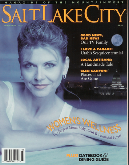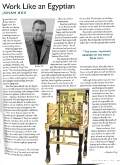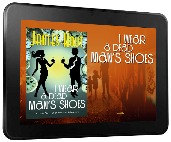Having worked with successful people, Johan has absorbed professional
techniques over the years. Writing copy and scripts were always part of
Johan’s responsibilities. A hundred+ television ads, seven feature
documentaries, various blogs, magazine articles including Mens Journal,
Cycle World, Salt Lake City Premier Magazine, many newspaper articles,
and a book are among his writing credits.



The Lamppost in My Living Room
(Marketing blog)
Written by Johan Bos
When friends and invited guests come to my home they immediately notice an obvious and recognizable object that I have proudly placed in my home. When the object is observed, in most cases the first thing that is said at my social gatherings is; “Why do you have a lamppost in your living room.” Before I answer that question for the readers let me describe the scene and the lamppost
As your enter my home there is a simple entry way that goes into a larger open area that includes an open kitchen, sitting area, living room, office and a living room. The lamppost is your typical black pole with a four sided lantern type light on top. It has the usual four pieces of glass which allow the light to spread and the pyramid shaped black cover with the gold painted eagle on top. Nothing too unusual. It's location however is not typical. The lamppost sits at the end of the walkway at the entrance to the sitting area which leads to the living room. Remember this is all basically open area, like one large room. Got the picture?
After I built this home I noticed there was a dark area at the end of the walkway that leads from the front door. Several common solutions came to mind without effort. A table with a lamp on it. A hanging lamp from the ceiling. A recessed light. Each of these solutions had a problem. No room for a table and lamp. A ceiling lamp would look out of place, and a recessed lamp would have worked but would involve some major remodel needed for the wiring. Sitting one night contemplating a solution my eye was caught by our lamppost in the yard which I could clearly see through the window. It was sleek and narrow not taking up more than eight inches of width. That lamp itself was up out of the way of anyone’s head, and spread light in all directions. Hmmn! “It will work” I said to myself.
The next morning I began to solve my lighting problem with the lamppost, not once giving any thought to the fact that it was an outdoor fixture and nobody really puts them in their houses. My lack of realizing this fact was over shadowed by the fact that the lamppost was a logical and simple solution. So I went out and bought one. By the end of the day the lamppost was in place ready for its night time test. Perfect! And, because this was all open area it even fit in with the décor, giving a sort of fancy feel to things. I realized that the solution was found by approaching things as I always do. Analyzing, and finding the most logical solution without my thinking being restricted by not including un-typical or un-traditional options. This is the thinking I always use when approaching a film project. I never let similar projects influence my creative decisions. I don't pattern my style or script after what has been done or is popular. As a result I end up with something that is unique and thus holds the audience attention. None of the programs I have submitted to the network have been rejected. I contribute this fact to the reason that I don't duplicate programs or style that are already out there, like I've been told is often the case with other producers submissions.
So, what is my answer when my friends ask the lamppost question? Well, even though I hate someone answering my question with a question, I say,”Why not a lamppost? And I have, to date, never been given an answer of why not. So I conclude with, don't be limited by what others have found for solutions, but continue thinking for other un-thought of solutions, they're there if you try.
My Friend Bob (Documentary film treatment)
Written by Johan Bos Copyright 2019, 2020 by Johan Vanden Bos
“This is Bob.” I was told by our host.
I had just entered the dinning room where a group of us had been invited for lunch.
Bob immediately stood up and stretched out his right hand towards me. I shook his hand, and included a friendly smile.
“Hi Bob. How are you?” I said, and then noticed Bob had a mouthful of food. He nodded his head a couple of times in efforts to indicate he was fine, while he quickly chewed and swallowed.
“I’m--fine. Thank you.”
He had crumbs on his lips and some salad dressing on his chin from the crackers he had been eating. He pulled a handkerchief from his pocket to wipe his mouth.
“I’m Johan.” I said, watching him clean the dressing from his chin.
“Oh, Johan. Nice--to meet you.”
His words were difficult to understand, but not because he was eating. He spoke with some sort of defect. Never the less, he was understandable. He stood fidgeting, looking intently at me, and not knowing exactly what to do. To break the un-comfort I said, “Well, I’ll let you get back to your lunch, Bob. It looks good. I think I’m going to get some of those crackers myself.” Bob sat down to carry on eating.
Bob had an obvious disability. His hands were unsteady, and he moved somewhat erratically and unstable. His words not well pronounced, and he stuttered as he searched for what he wanted to say.
After lunch we talked more, and I learned that Bob was quite polite and mannered. He also loved to talk. That afternoon, as the other guests left, Bob was driven home. I didn’t see Bob again for almost a year.
At the time I had no idea that we would become friends, and how involved in his life I would become. That’s how I met Bob.
“My Friend Bob” is a 60-minute documentary about Bob and his dream of seeing America’s landmarks.
Bob lives alone, and even though he can live primarily unassisted, he often needs help with repairs in and around his home. That’s where I came in. After about the third time I saw Bob, through the same circumstances as the first time we met, Bob opened up to me. He told me of his desire to attend church, and his difficulty in getting to church. I asked Bob where he lived, and it wasn’t far from where my family and I attended church. So I made the obvious suggestion that we pick him up on Sunday mornings.
Next thing I knew, I was installing phone lines, repairing leaky faucets, and a number of other tasks that Bob was unable to do or understand. As a result, we got to know Bob better and better. He is open, and refreshingly honest about his feelings, and he isn’t afraid to express his opinion. I also learned that he had never attended a baseball game. He told me he is a Mariners fan, and someday hopes to actually sit and watch a game in the stadium. In curiosity, I asked Bob his other dreams and hopes. “To see--Las--Vegas and other parts--of America” and before he’s too old, he tells me. Then his eyes gleamed with delight as he said; “I want to eat one of those famous hot dogs from “The Chili Bowl” in Washington DC.” We'll certainly try, I told him.
Well, I made arrangements to take Bob to T-Mobile Park In Seattle this year for the beginning of the Mariner’s season. He was excited, and can talk of nothing else.
I later asked Bob, “If we could make a trip across country, would you go? And could we film it for television?”
He smiled ear to ear and said “Oh yeah!”
I elaborated on the fact that a camera crew would be with us all the time, filming us talk, drive, and meeting new people.
“Oh that won’t bother me.” Bob says.
So this year, Bob and I will be at his first baseball game at T-Mobile Park, and with a little luck, that will kick off our journey on Bob’s lifetime adventure to see America. Then, as America watches, Bob and I will see the sites of his dreams, meet and talk to regular people, maybe a few celebrities, oh yeah, and possibly even share a famous DC hot dog with Donald Trump.


Television & Media Writing Graphic Art / Design Management Skills Adobe Skills / Photography Contact

Forgotten Family
One Man's Search For The Family His Parents Left Behind Written by Johan Bos
Searching on the Internet the other day for genealogy organizations I came across several companies. I became impressed with the advantages of modern technology and how it has affected genealogical research. I was immediately interested. For decades I've longed to know my forgotten family, the family that my parents left behind. My curiosity began many years ago with the routine arrival of what I now call, The Mathijssen Boxes.
When I was a young boy, once or twice a year a delivery would find it’s way to our door, a box delivered to our home from Holland. The box was roughly fifteen to eighteen inches square and about ten to twelve inches deep. I remember the cardboard box; it differed from the typical cardboard I was used to seeing. It also had unusual writing on it and unfamiliar postage. The box would remain closed until my father came home from work, and before we sat down to dinner, my mother would open the box. The contents of the box would bring us delight as it always did, even though the contents varied each time. Then as always, like the previous boxes, that night I would hear my mother crying in her bedroom. But let me backup a little.
Around 1942, a young man twenty-two years old was taken from his home in Amsterdam and put on a train for France. Once there he was forced, at gun point by German soldiers, to load trains with goods bound for Germany. Many men were killed trying to escape in efforts to return home to their families. On one particular day there came an opportunity. Gun fire began while the trains were being loaded. French resistance tried to stop the looting. The German soldiers scattered and this twenty two year old boy began to run. He managed to get away and hide. With help he returned to Holland only to find many of his family had starved.
At this same time in Holland there was a fifteen year old girl living with her father and older sister. To stay warm her sister and her would walk along the train tracks and collect pieces of coal that fell from the locomotives. On this particular day missiles from Germany flew overhead with intended targets in England, but this time, as it often did, the missles fell in Holland. The girl and her sister rushed home to find their house bombed and father and mother killed.
So why the stories of these two young people? Because years later these two met, got married, emigrated to America and had a son. That's where I come in. I grew up more or less having a typical childhood. Except for one thing. Our neighborhood was often filled with family reunions, the kind of gatherings that were not part of our life. Kids in my neighborhood often asked, “Where's your grandma and grandpa?” “I don't have any.” was my reply. Yet I often thought to myself, how many relatives do I actually have. My father was the youngest of eleven children, my mother the youngest of ten. Where are they? Who are they? I know nothing about them.
This treatment is for a documentary film, seen by a national network audience as they follow this quest, the research involved, and how your company is the invaluable tool featured in the step-by-step process of beginning the emotional discovery of finding and uniting the forgotten family. I’m sure you can appreciate the image building advantages of participating in a program like this, which can translate into the popular format of a series.
As you have read in the cover letter, this program can reach an audience of up to 90 million households, as I have done several times before with similar projects.
What about the boxes? When I asked my mother where the boxes came from, she told me this; During the war her older sister gave help to the Jewish people. Her role was never explained to me. However, when the war ended, my aunt gained the recognition of a Jewish organization, and given a certain some of money each year for her help during the war. My aunt in turn shared the money with her brothers and sister in the form of traditional food and goodies from Holland, things that were unavailable to us here in America. The contents of the box brought pleasure, but in addition, for my mother, it also brought difficult memories, explaining the tears of grief at the end of the day. Because the boxes came from my mothers side of the family we called it the Mathijssen box, her maiden name.
I'm hoping that this genealogical journey will not only reveal my living relatives, but also some details about the lives of my aunts, uncles and their children, my Forgotten Family. And with some luck the efforts will hopefully lead up to my first recorded family reunion.
We hope that your company will see the potential benefits in funding this nationally aired program, and how strongly it can encourage others to take part in your services.


Written by Rebecca and Johan Bos
Television & Media Writing Graphic Art / Design Management Skills Adobe Skills / Photography Contact
Subjects covered in this portfolio. Click area of interest
I Don't Speak Your Language
(Marketing blog)
Written by Johan Bos
Ik wil u graag vertellen over taal en communicatie. Het is belangrijk dat onze boodschap niet alleen om de juiste mensen gaat, maar in woorden die zij begrijpen.
No you're not on a foreign web page. I'm using my original language to make a point. First let me translate. “I would like to tell you about language and communication. It is important that our message not only get to the right people, but in words that they understand.”
So what do I mean by this? For any type of marketing to be effective we must know several important things before we start. Two of these are; Who is our customer or client? Wear are they? One of the often forgotten questions is; What language do they speak? Now I don't mean what foreign language do they speak, but does our audience understand our message. Different demographics of people hear and connect with certain ways of saying things better than other ways. For example; The term “helicopter parents”. When heard, some people will know that means “over protective parents”. Others will only understand if you say “over protective parents”. Good marketing will take into account different terms, slang, etc. But that is only one side of “speaking someones language”. Have you ever heard the phrase, “Now you're speaking my language!” Often times we may have heard that phrase when someone is handing someone some money. When you speak with someone about their hobbies or interests you are also “speaking their language”. Speaking someone's language is connecting with them on subjects they understand or are passionate about. You must also use terms that they use when they speak about the things they enjoy.
I have found all too often that in house marketing departments lack greatly in this area of communicating with their potential customers/clients. For the most part in house marketing can do a good job, but need the help of agencies to pick up the slack where they fall short. Proper research is another area where in house needs help.
So how do you learn the language of your target audience? Again, that's why there are experts. Content for your marketing campaign is vital.
I would not use words of a biker to sell formal wear. However, to sell Harley Davidson Motorcycles I would lean more that direction. I realize that example is quite obvious, although I've known some marketing materials to be that far off base. Unfortunately most products or services are not that cut and dry when it comes to knowing how to catch the ears of your customer.
Images as well as words can also connect and speak to someone. I'm going to use an old cliche' to make a point. You can say it with me if you like. “A picture is worth a thousand words.” If that is true then you must know the words connected with that picture, especially if there is a thousand of them. What good is an image if the words associated with it don't connect with your customer. It may even turn your customer away. Oh, No. We didn't think of that. Well those of us in the advertising industry do think of those things all the time. All in all, analyze your content carefully, and roep een expert als je nodig hebt. (call an expert if you need to.)

Featured in
